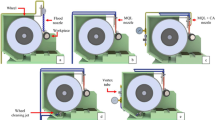Abstract
The application of minimum quantity of lubricant (MQL) in grinding process is a challenging task. Once the MQL is considered an environmentally friendly technique, its implementation in grinding process is interesting to achieve cleaner production. On the other hand, its use brings some problems to the process, such as intensification of grinding wheel clogging phenomenon and increase of cutting temperatures, which impairs on the attainment of a good surface quality, together with dimensional and geometrical accuracy. Looking for improving the MQL efficiency in grinding process, two eco-friendly techniques were found: the addition of water in the MQL and the wheel cleaning system with compressed air. The present research seeks to evaluate the improvement of MQL application in grinding using the combination of these techniques. Both techniques MQL + water and wheel cleaning system are innovative, since there are almost no articles in literature citing its use. The experiments were performed in an external cylindrical plunge grinding using a vitrified cubic boron nitrite (CBN) grinding wheel. The workpiece material was a quenched and tempered AISI 4340 steel. The cooling methods employed in the process were a conventional method (flood coolant), MQL + water (1:1, 1:3, 1:5 part of oil per parts of water), MQL + water + cleaning system (1:1, 1:3, 1:5 part of oil per parts of water), and MQL with and without cleaning system. Results were analyzed based on some workpiece parameters (roughness, roundness deviation, and microstructure) and on diametrical wheel wear and grinding power. The addition of water allied to cleaning system with compressed air provided the best results among those using the MQL technique, with results comparable to the conventional cooling method.
Similar content being viewed by others
References
Sinot O, Chevrier P, Padilla P (2006) Experimental simulation of the efficiency of high speed grinding wheel cleaning. Int J Mach Tool Manuf 46(2):170–175. https://doi.org/10.1016/j.ijmachtools.2005.04.016
Cameron A, Bauer R, Warkentin A (2010) An investigation of the effects of wheel cleaning parameters in creep-feed grinding. Int J Mach Tool Manuf 50(1):126–130. https://doi.org/10.1016/j.ijmachtools.2009.08.008
Sadegui MH, Hadad MJ, Tawakoli T, Vesali A, Emami M (2010) An investigation on surface grinding of AISI 4140 hardened steel using minimum quantity lubrication-MQL technique. Int J Mater Form 3:241–251
Webster J A (2008) Coolant calculus: directing into the right place at the right speed, in The right quantity, cutting tool technology 60(2):58–66
Oliveira DJ, Guermandi LG, Bianchi EC, Diniz AE, Aguiar PR, Canarim RC (2012) Improving minimum quantity lubrication in CBN grinding using compressed air wheel cleaning. J Mater Process Technol 212:2559–2568
Shokrani A, Dhokia V, Newman ST (2012) Environmentally conscious machining of difficult-to-machine materials with regard cutting fluids. Int J Mach Tool Manuf 57:83–101. https://doi.org/10.1016/j.ijmachtools.2012.02.002
Yoshimura H, Itogawa F, Nakamura T, Niwa K (2005) Development of nozzle system for oil-on-water droplet metalworking fluid and its application to practical production line. JSME Int J 48(4):723–729. https://doi.org/10.1299/jsmec.48.723
Belentani RM, Funes H Jr, Canarim RC, Diniz AE, Hassui A, Aguiar PR, Bianchi EC (2014) Utilization of minimum quantity lubrication (MQL) with water in CBN grinding of steel. Mater Res 17:88–96
Mao C, Tang X, Zou H, Zhou Z, Yin W (2012) Experimental investigation of surface quality for minimum quantity oil-water lubrication grinding. Int J Adv Manuf Technol 59(1-4):93–100. https://doi.org/10.1007/s00170-011-3491-3
Walker T (2013) MQLhandbook: a guide to machining with minimum quantity lubrication, 1° ed., Unist, Inc. V1.0.3
Silva LR, Corrêa ECS, Brandão JR, Ávila RF (2013) Environmentally friendly manufacturing: behavior analysis of minimum quantity of lubricant-MQL in grinding process. J Clean Prod. https://doi.org/10.1016/j.jclepro.2013.01.033
Rowe WB (2014) Principles of modern grinding technology, 2nd edn. William Andrew, Waltham
Funding
Special thanks to FAPESP (State of São Paulo Research Assistance Foundation—Process Number 2015/09868-9) for providing the financial resources for the research, and the authors sincerely thank the companies ITW Chemical Products and Quimatic Tapmatic for donating some of the support material.
Author information
Authors and Affiliations
Corresponding author
Ethics declarations
Conflict of interests
The authors declare that they have no conflict of interest.
Rights and permissions
About this article
Cite this article
Bianchi, E.C., Sato, B.K., Sales, A.R. et al. Evaluating the effect of the compressed air wheel cleaning in grinding the AISI 4340 steel with CBN and MQL with water. Int J Adv Manuf Technol 95, 2855–2864 (2018). https://doi.org/10.1007/s00170-017-1433-4
Received:
Accepted:
Published:
Issue Date:
DOI: https://doi.org/10.1007/s00170-017-1433-4



